Is Social Media the Future of Marketing for Australian Automobiles?
VerifiedAdded on 2023/01/16
|20
|5693
|20
Report
AI Summary
This research report investigates the significance of social media marketing within the Australian automobile industry. It begins with an introduction highlighting the transformative impact of social media, particularly in the context of globalized markets and technological advancements. The report outlines the research aim, objectives, and hypothesis, focusing on the advantages, disadvantages, and potential profitability enhancements of social media marketing compared to traditional methods. A comprehensive literature review delves into the multifaceted aspects of social media, including its evolution, various platforms, and influence on communication, information dissemination, and community building. The review also addresses the advantages of social media marketing, such as increased brand awareness and direct customer interaction, alongside its disadvantages, including data security concerns and potential health impacts. Furthermore, the report examines the application of social media marketing strategies, its impact on the Australian automobile industry, and its potential for enhancing profitability. This report provides valuable insights into the evolving marketing landscape and the strategic importance of social media in the automotive sector.
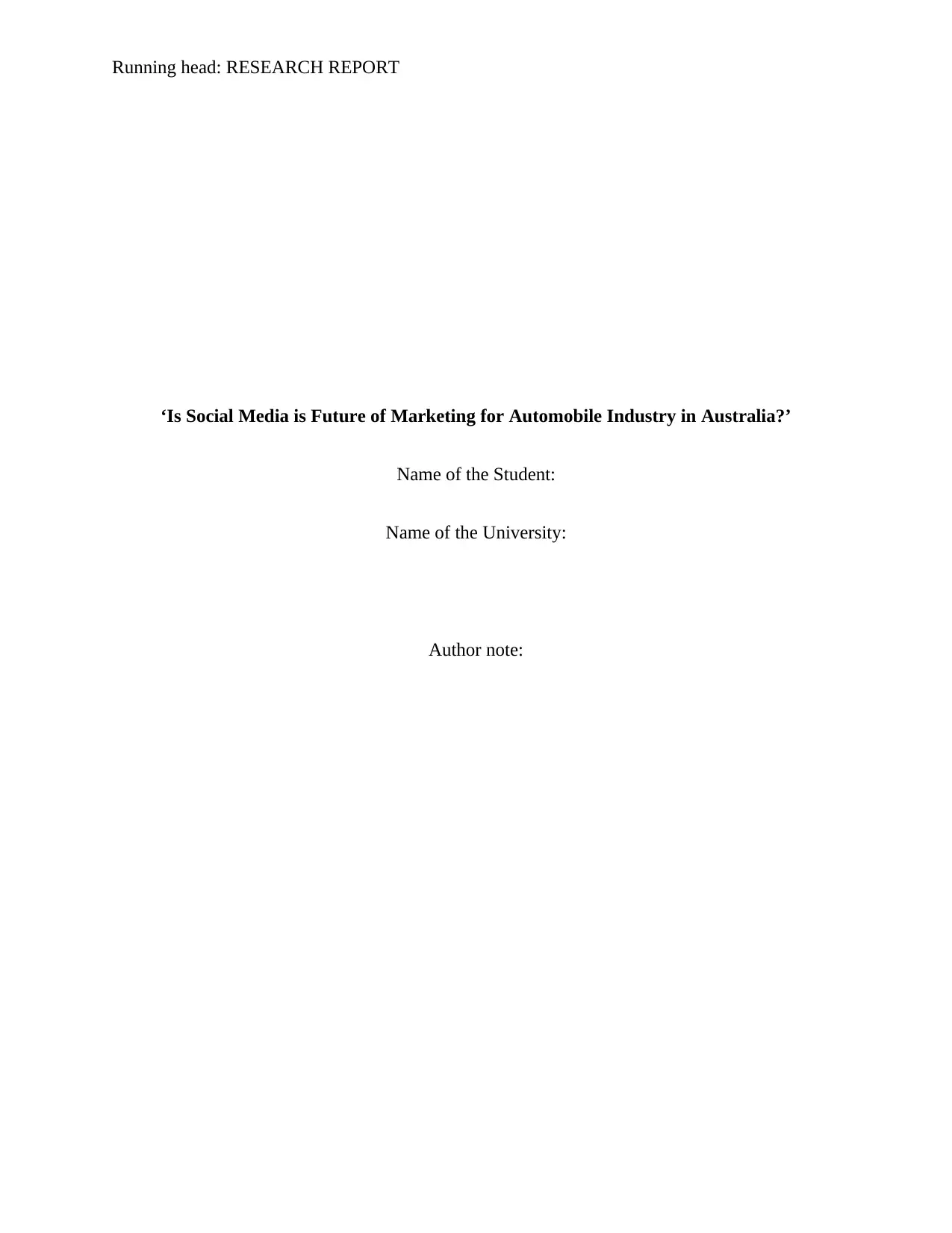
Running head: RESEARCH REPORT
‘Is Social Media is Future of Marketing for Automobile Industry in Australia?’
Name of the Student:
Name of the University:
Author note:
‘Is Social Media is Future of Marketing for Automobile Industry in Australia?’
Name of the Student:
Name of the University:
Author note:
Paraphrase This Document
Need a fresh take? Get an instant paraphrase of this document with our AI Paraphraser
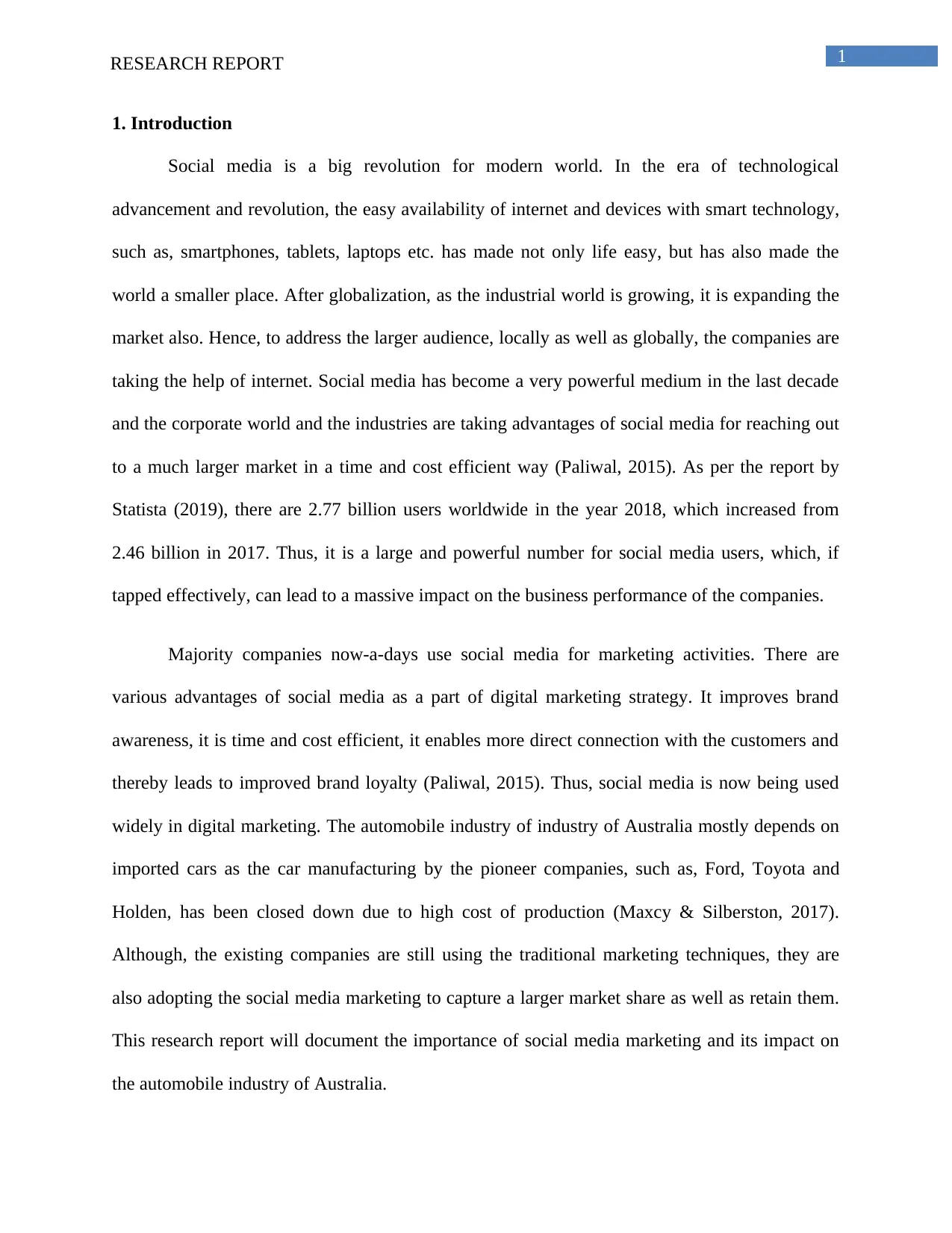
1RESEARCH REPORT
1. Introduction
Social media is a big revolution for modern world. In the era of technological
advancement and revolution, the easy availability of internet and devices with smart technology,
such as, smartphones, tablets, laptops etc. has made not only life easy, but has also made the
world a smaller place. After globalization, as the industrial world is growing, it is expanding the
market also. Hence, to address the larger audience, locally as well as globally, the companies are
taking the help of internet. Social media has become a very powerful medium in the last decade
and the corporate world and the industries are taking advantages of social media for reaching out
to a much larger market in a time and cost efficient way (Paliwal, 2015). As per the report by
Statista (2019), there are 2.77 billion users worldwide in the year 2018, which increased from
2.46 billion in 2017. Thus, it is a large and powerful number for social media users, which, if
tapped effectively, can lead to a massive impact on the business performance of the companies.
Majority companies now-a-days use social media for marketing activities. There are
various advantages of social media as a part of digital marketing strategy. It improves brand
awareness, it is time and cost efficient, it enables more direct connection with the customers and
thereby leads to improved brand loyalty (Paliwal, 2015). Thus, social media is now being used
widely in digital marketing. The automobile industry of industry of Australia mostly depends on
imported cars as the car manufacturing by the pioneer companies, such as, Ford, Toyota and
Holden, has been closed down due to high cost of production (Maxcy & Silberston, 2017).
Although, the existing companies are still using the traditional marketing techniques, they are
also adopting the social media marketing to capture a larger market share as well as retain them.
This research report will document the importance of social media marketing and its impact on
the automobile industry of Australia.
1. Introduction
Social media is a big revolution for modern world. In the era of technological
advancement and revolution, the easy availability of internet and devices with smart technology,
such as, smartphones, tablets, laptops etc. has made not only life easy, but has also made the
world a smaller place. After globalization, as the industrial world is growing, it is expanding the
market also. Hence, to address the larger audience, locally as well as globally, the companies are
taking the help of internet. Social media has become a very powerful medium in the last decade
and the corporate world and the industries are taking advantages of social media for reaching out
to a much larger market in a time and cost efficient way (Paliwal, 2015). As per the report by
Statista (2019), there are 2.77 billion users worldwide in the year 2018, which increased from
2.46 billion in 2017. Thus, it is a large and powerful number for social media users, which, if
tapped effectively, can lead to a massive impact on the business performance of the companies.
Majority companies now-a-days use social media for marketing activities. There are
various advantages of social media as a part of digital marketing strategy. It improves brand
awareness, it is time and cost efficient, it enables more direct connection with the customers and
thereby leads to improved brand loyalty (Paliwal, 2015). Thus, social media is now being used
widely in digital marketing. The automobile industry of industry of Australia mostly depends on
imported cars as the car manufacturing by the pioneer companies, such as, Ford, Toyota and
Holden, has been closed down due to high cost of production (Maxcy & Silberston, 2017).
Although, the existing companies are still using the traditional marketing techniques, they are
also adopting the social media marketing to capture a larger market share as well as retain them.
This research report will document the importance of social media marketing and its impact on
the automobile industry of Australia.
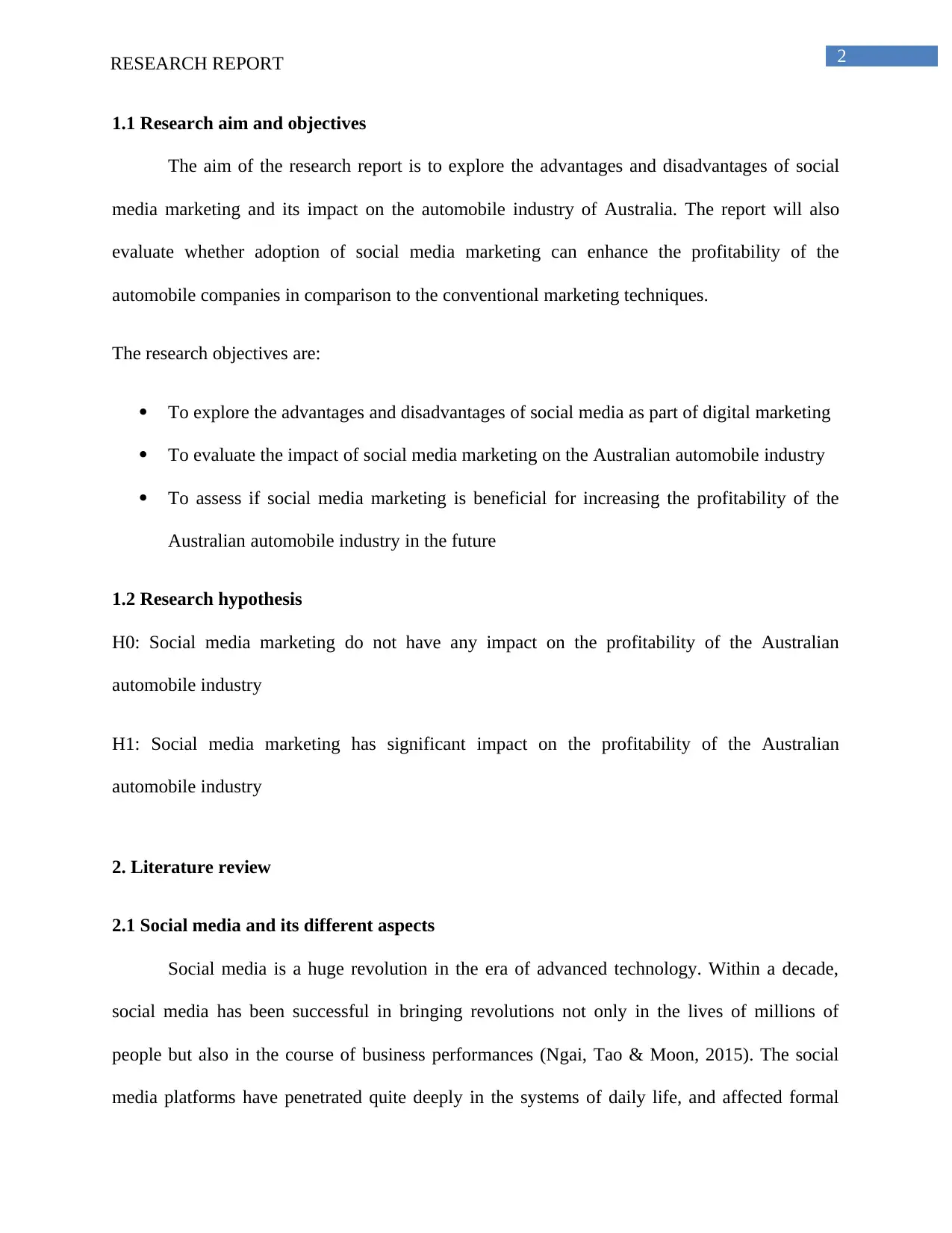
2RESEARCH REPORT
1.1 Research aim and objectives
The aim of the research report is to explore the advantages and disadvantages of social
media marketing and its impact on the automobile industry of Australia. The report will also
evaluate whether adoption of social media marketing can enhance the profitability of the
automobile companies in comparison to the conventional marketing techniques.
The research objectives are:
To explore the advantages and disadvantages of social media as part of digital marketing
To evaluate the impact of social media marketing on the Australian automobile industry
To assess if social media marketing is beneficial for increasing the profitability of the
Australian automobile industry in the future
1.2 Research hypothesis
H0: Social media marketing do not have any impact on the profitability of the Australian
automobile industry
H1: Social media marketing has significant impact on the profitability of the Australian
automobile industry
2. Literature review
2.1 Social media and its different aspects
Social media is a huge revolution in the era of advanced technology. Within a decade,
social media has been successful in bringing revolutions not only in the lives of millions of
people but also in the course of business performances (Ngai, Tao & Moon, 2015). The social
media platforms have penetrated quite deeply in the systems of daily life, and affected formal
1.1 Research aim and objectives
The aim of the research report is to explore the advantages and disadvantages of social
media marketing and its impact on the automobile industry of Australia. The report will also
evaluate whether adoption of social media marketing can enhance the profitability of the
automobile companies in comparison to the conventional marketing techniques.
The research objectives are:
To explore the advantages and disadvantages of social media as part of digital marketing
To evaluate the impact of social media marketing on the Australian automobile industry
To assess if social media marketing is beneficial for increasing the profitability of the
Australian automobile industry in the future
1.2 Research hypothesis
H0: Social media marketing do not have any impact on the profitability of the Australian
automobile industry
H1: Social media marketing has significant impact on the profitability of the Australian
automobile industry
2. Literature review
2.1 Social media and its different aspects
Social media is a huge revolution in the era of advanced technology. Within a decade,
social media has been successful in bringing revolutions not only in the lives of millions of
people but also in the course of business performances (Ngai, Tao & Moon, 2015). The social
media platforms have penetrated quite deeply in the systems of daily life, and affected formal
⊘ This is a preview!⊘
Do you want full access?
Subscribe today to unlock all pages.

Trusted by 1+ million students worldwide
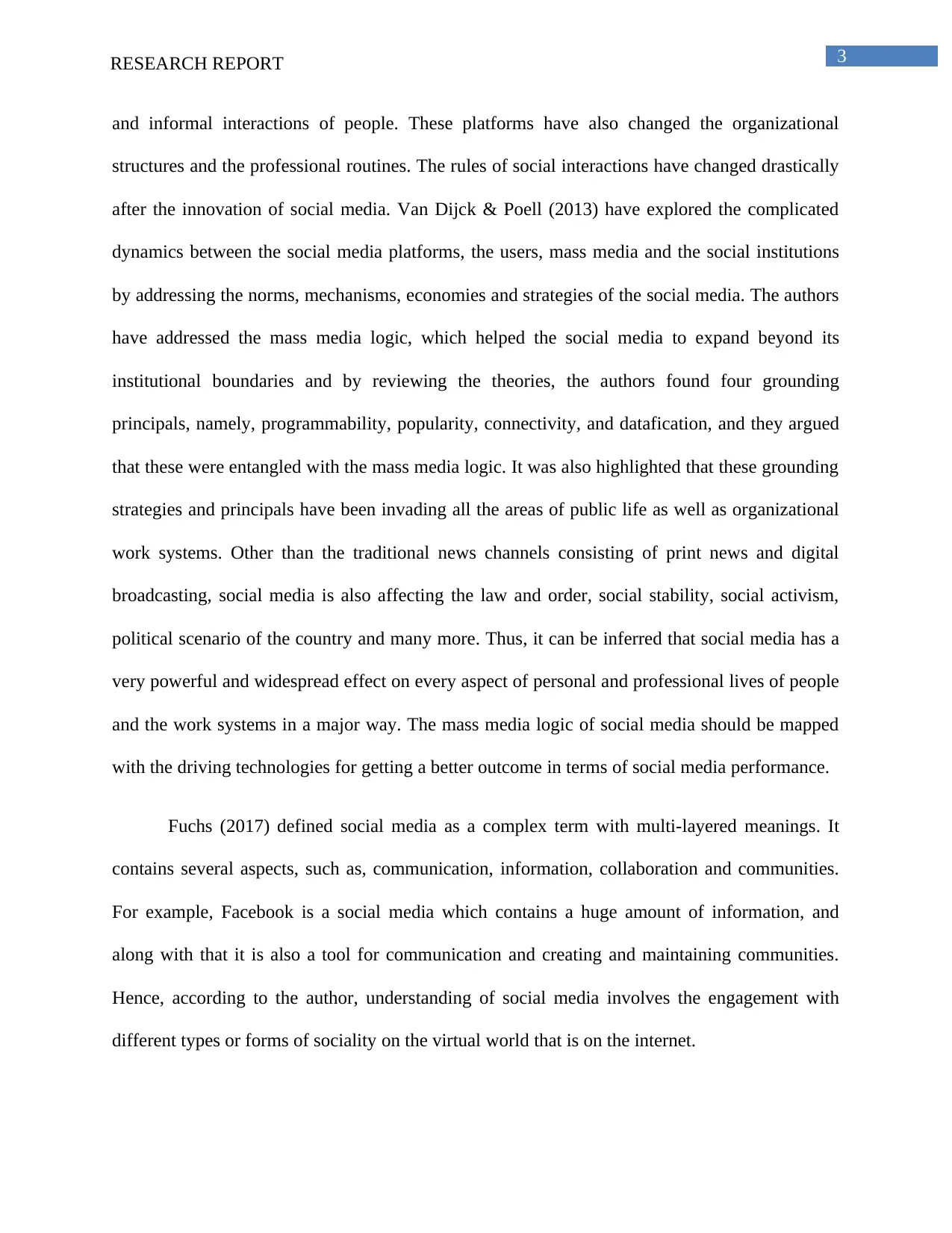
3RESEARCH REPORT
and informal interactions of people. These platforms have also changed the organizational
structures and the professional routines. The rules of social interactions have changed drastically
after the innovation of social media. Van Dijck & Poell (2013) have explored the complicated
dynamics between the social media platforms, the users, mass media and the social institutions
by addressing the norms, mechanisms, economies and strategies of the social media. The authors
have addressed the mass media logic, which helped the social media to expand beyond its
institutional boundaries and by reviewing the theories, the authors found four grounding
principals, namely, programmability, popularity, connectivity, and datafication, and they argued
that these were entangled with the mass media logic. It was also highlighted that these grounding
strategies and principals have been invading all the areas of public life as well as organizational
work systems. Other than the traditional news channels consisting of print news and digital
broadcasting, social media is also affecting the law and order, social stability, social activism,
political scenario of the country and many more. Thus, it can be inferred that social media has a
very powerful and widespread effect on every aspect of personal and professional lives of people
and the work systems in a major way. The mass media logic of social media should be mapped
with the driving technologies for getting a better outcome in terms of social media performance.
Fuchs (2017) defined social media as a complex term with multi-layered meanings. It
contains several aspects, such as, communication, information, collaboration and communities.
For example, Facebook is a social media which contains a huge amount of information, and
along with that it is also a tool for communication and creating and maintaining communities.
Hence, according to the author, understanding of social media involves the engagement with
different types or forms of sociality on the virtual world that is on the internet.
and informal interactions of people. These platforms have also changed the organizational
structures and the professional routines. The rules of social interactions have changed drastically
after the innovation of social media. Van Dijck & Poell (2013) have explored the complicated
dynamics between the social media platforms, the users, mass media and the social institutions
by addressing the norms, mechanisms, economies and strategies of the social media. The authors
have addressed the mass media logic, which helped the social media to expand beyond its
institutional boundaries and by reviewing the theories, the authors found four grounding
principals, namely, programmability, popularity, connectivity, and datafication, and they argued
that these were entangled with the mass media logic. It was also highlighted that these grounding
strategies and principals have been invading all the areas of public life as well as organizational
work systems. Other than the traditional news channels consisting of print news and digital
broadcasting, social media is also affecting the law and order, social stability, social activism,
political scenario of the country and many more. Thus, it can be inferred that social media has a
very powerful and widespread effect on every aspect of personal and professional lives of people
and the work systems in a major way. The mass media logic of social media should be mapped
with the driving technologies for getting a better outcome in terms of social media performance.
Fuchs (2017) defined social media as a complex term with multi-layered meanings. It
contains several aspects, such as, communication, information, collaboration and communities.
For example, Facebook is a social media which contains a huge amount of information, and
along with that it is also a tool for communication and creating and maintaining communities.
Hence, according to the author, understanding of social media involves the engagement with
different types or forms of sociality on the virtual world that is on the internet.
Paraphrase This Document
Need a fresh take? Get an instant paraphrase of this document with our AI Paraphraser
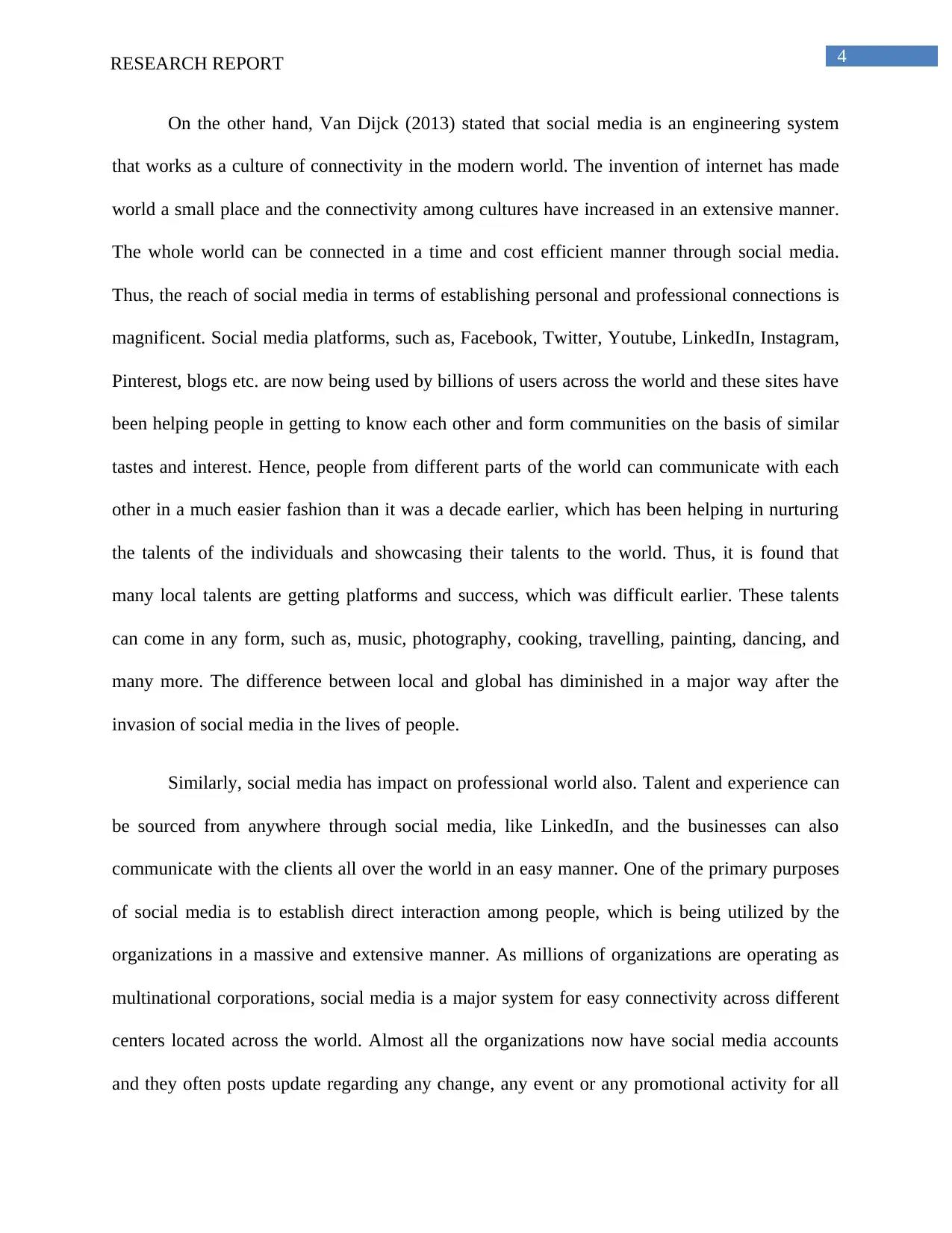
4RESEARCH REPORT
On the other hand, Van Dijck (2013) stated that social media is an engineering system
that works as a culture of connectivity in the modern world. The invention of internet has made
world a small place and the connectivity among cultures have increased in an extensive manner.
The whole world can be connected in a time and cost efficient manner through social media.
Thus, the reach of social media in terms of establishing personal and professional connections is
magnificent. Social media platforms, such as, Facebook, Twitter, Youtube, LinkedIn, Instagram,
Pinterest, blogs etc. are now being used by billions of users across the world and these sites have
been helping people in getting to know each other and form communities on the basis of similar
tastes and interest. Hence, people from different parts of the world can communicate with each
other in a much easier fashion than it was a decade earlier, which has been helping in nurturing
the talents of the individuals and showcasing their talents to the world. Thus, it is found that
many local talents are getting platforms and success, which was difficult earlier. These talents
can come in any form, such as, music, photography, cooking, travelling, painting, dancing, and
many more. The difference between local and global has diminished in a major way after the
invasion of social media in the lives of people.
Similarly, social media has impact on professional world also. Talent and experience can
be sourced from anywhere through social media, like LinkedIn, and the businesses can also
communicate with the clients all over the world in an easy manner. One of the primary purposes
of social media is to establish direct interaction among people, which is being utilized by the
organizations in a massive and extensive manner. As millions of organizations are operating as
multinational corporations, social media is a major system for easy connectivity across different
centers located across the world. Almost all the organizations now have social media accounts
and they often posts update regarding any change, any event or any promotional activity for all
On the other hand, Van Dijck (2013) stated that social media is an engineering system
that works as a culture of connectivity in the modern world. The invention of internet has made
world a small place and the connectivity among cultures have increased in an extensive manner.
The whole world can be connected in a time and cost efficient manner through social media.
Thus, the reach of social media in terms of establishing personal and professional connections is
magnificent. Social media platforms, such as, Facebook, Twitter, Youtube, LinkedIn, Instagram,
Pinterest, blogs etc. are now being used by billions of users across the world and these sites have
been helping people in getting to know each other and form communities on the basis of similar
tastes and interest. Hence, people from different parts of the world can communicate with each
other in a much easier fashion than it was a decade earlier, which has been helping in nurturing
the talents of the individuals and showcasing their talents to the world. Thus, it is found that
many local talents are getting platforms and success, which was difficult earlier. These talents
can come in any form, such as, music, photography, cooking, travelling, painting, dancing, and
many more. The difference between local and global has diminished in a major way after the
invasion of social media in the lives of people.
Similarly, social media has impact on professional world also. Talent and experience can
be sourced from anywhere through social media, like LinkedIn, and the businesses can also
communicate with the clients all over the world in an easy manner. One of the primary purposes
of social media is to establish direct interaction among people, which is being utilized by the
organizations in a massive and extensive manner. As millions of organizations are operating as
multinational corporations, social media is a major system for easy connectivity across different
centers located across the world. Almost all the organizations now have social media accounts
and they often posts update regarding any change, any event or any promotional activity for all
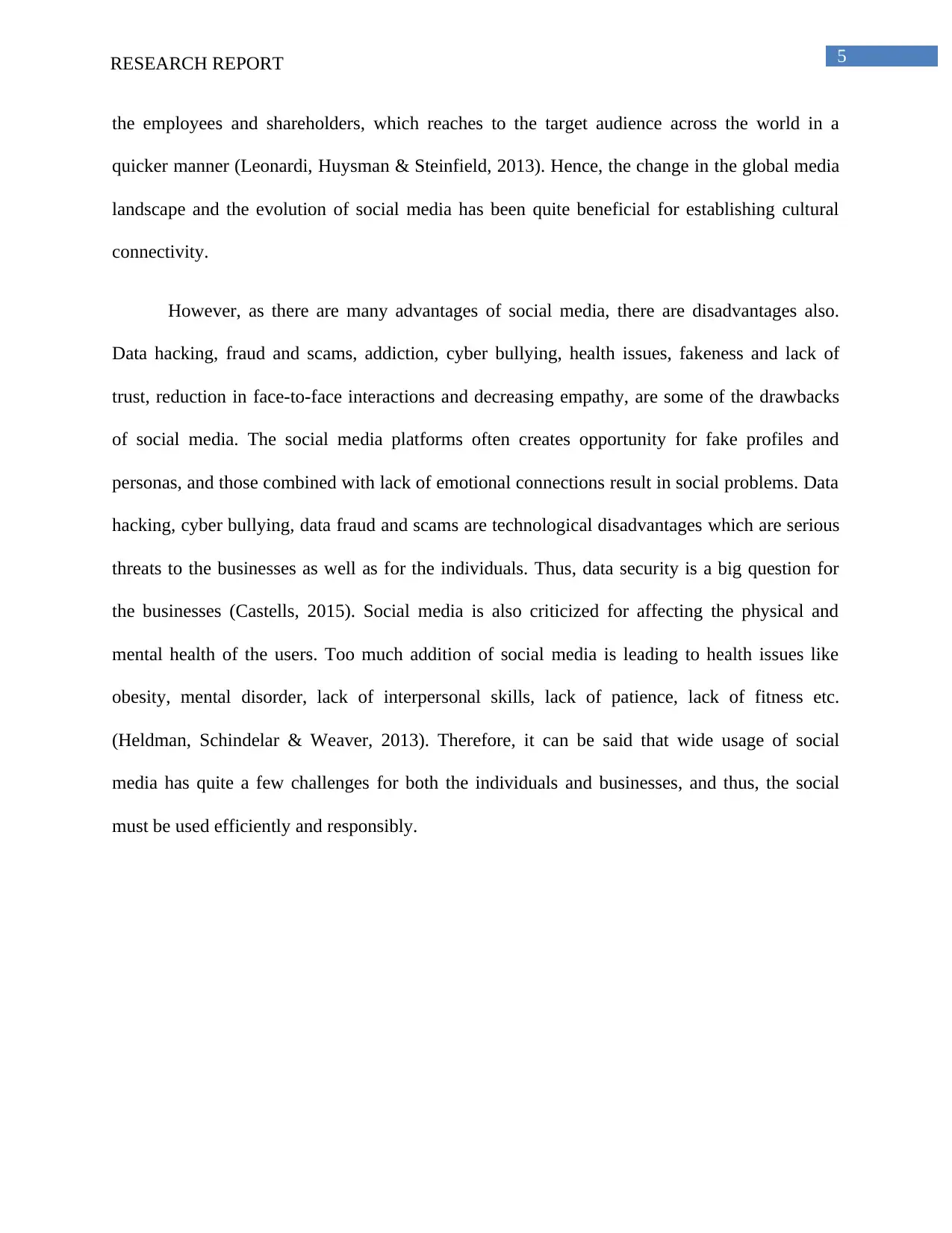
5RESEARCH REPORT
the employees and shareholders, which reaches to the target audience across the world in a
quicker manner (Leonardi, Huysman & Steinfield, 2013). Hence, the change in the global media
landscape and the evolution of social media has been quite beneficial for establishing cultural
connectivity.
However, as there are many advantages of social media, there are disadvantages also.
Data hacking, fraud and scams, addiction, cyber bullying, health issues, fakeness and lack of
trust, reduction in face-to-face interactions and decreasing empathy, are some of the drawbacks
of social media. The social media platforms often creates opportunity for fake profiles and
personas, and those combined with lack of emotional connections result in social problems. Data
hacking, cyber bullying, data fraud and scams are technological disadvantages which are serious
threats to the businesses as well as for the individuals. Thus, data security is a big question for
the businesses (Castells, 2015). Social media is also criticized for affecting the physical and
mental health of the users. Too much addition of social media is leading to health issues like
obesity, mental disorder, lack of interpersonal skills, lack of patience, lack of fitness etc.
(Heldman, Schindelar & Weaver, 2013). Therefore, it can be said that wide usage of social
media has quite a few challenges for both the individuals and businesses, and thus, the social
must be used efficiently and responsibly.
the employees and shareholders, which reaches to the target audience across the world in a
quicker manner (Leonardi, Huysman & Steinfield, 2013). Hence, the change in the global media
landscape and the evolution of social media has been quite beneficial for establishing cultural
connectivity.
However, as there are many advantages of social media, there are disadvantages also.
Data hacking, fraud and scams, addiction, cyber bullying, health issues, fakeness and lack of
trust, reduction in face-to-face interactions and decreasing empathy, are some of the drawbacks
of social media. The social media platforms often creates opportunity for fake profiles and
personas, and those combined with lack of emotional connections result in social problems. Data
hacking, cyber bullying, data fraud and scams are technological disadvantages which are serious
threats to the businesses as well as for the individuals. Thus, data security is a big question for
the businesses (Castells, 2015). Social media is also criticized for affecting the physical and
mental health of the users. Too much addition of social media is leading to health issues like
obesity, mental disorder, lack of interpersonal skills, lack of patience, lack of fitness etc.
(Heldman, Schindelar & Weaver, 2013). Therefore, it can be said that wide usage of social
media has quite a few challenges for both the individuals and businesses, and thus, the social
must be used efficiently and responsibly.
⊘ This is a preview!⊘
Do you want full access?
Subscribe today to unlock all pages.

Trusted by 1+ million students worldwide
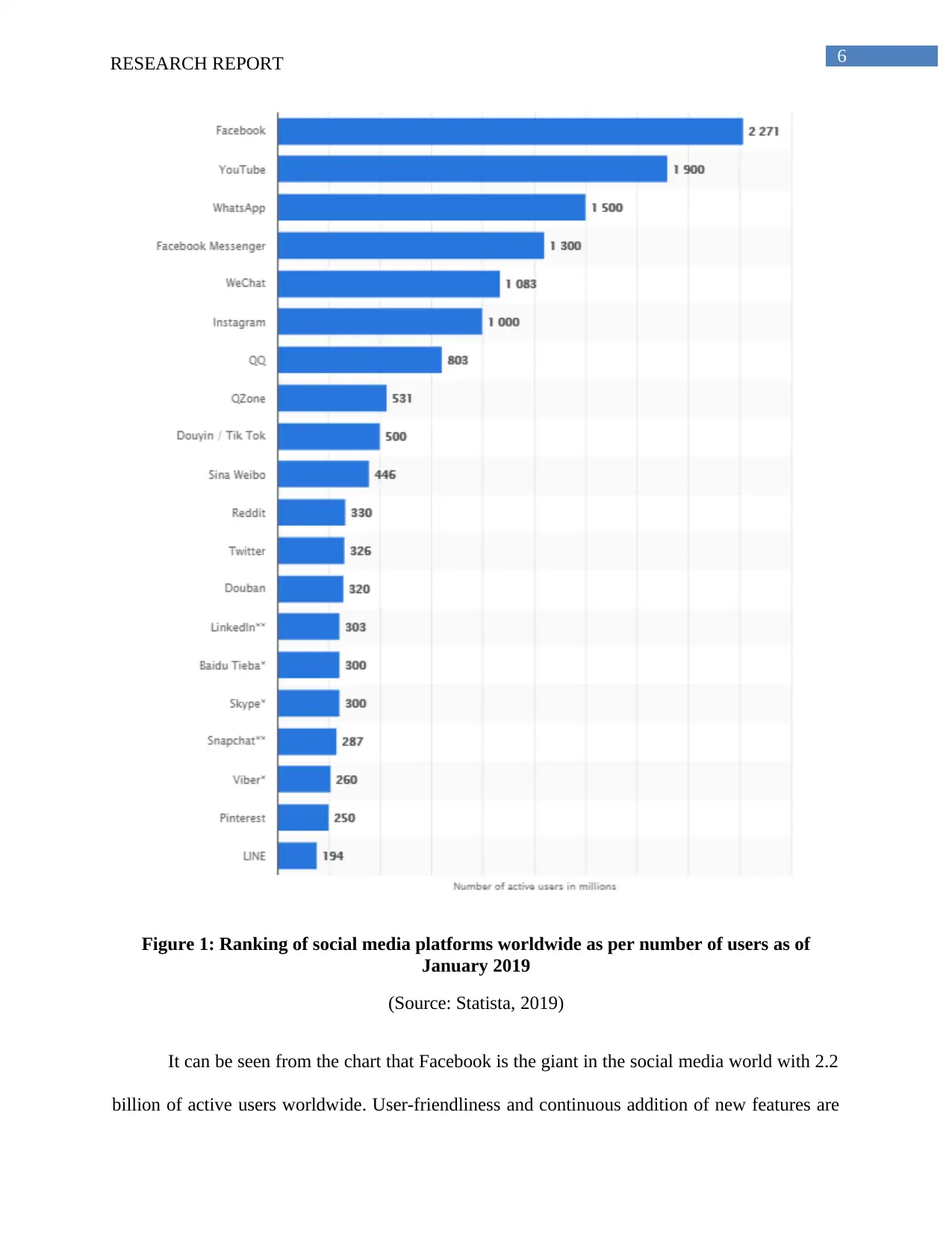
6RESEARCH REPORT
Figure 1: Ranking of social media platforms worldwide as per number of users as of
January 2019
(Source: Statista, 2019)
It can be seen from the chart that Facebook is the giant in the social media world with 2.2
billion of active users worldwide. User-friendliness and continuous addition of new features are
Figure 1: Ranking of social media platforms worldwide as per number of users as of
January 2019
(Source: Statista, 2019)
It can be seen from the chart that Facebook is the giant in the social media world with 2.2
billion of active users worldwide. User-friendliness and continuous addition of new features are
Paraphrase This Document
Need a fresh take? Get an instant paraphrase of this document with our AI Paraphraser
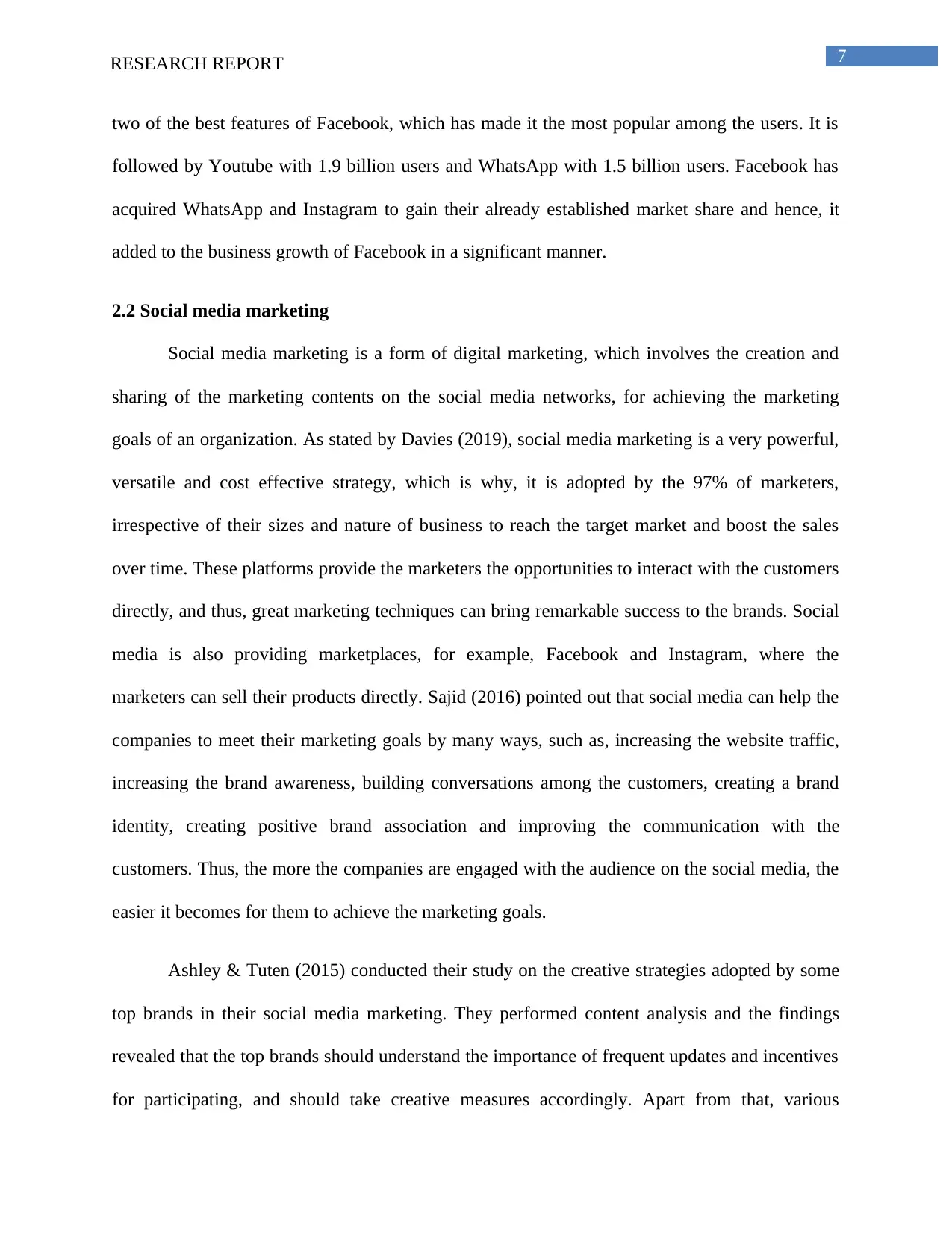
7RESEARCH REPORT
two of the best features of Facebook, which has made it the most popular among the users. It is
followed by Youtube with 1.9 billion users and WhatsApp with 1.5 billion users. Facebook has
acquired WhatsApp and Instagram to gain their already established market share and hence, it
added to the business growth of Facebook in a significant manner.
2.2 Social media marketing
Social media marketing is a form of digital marketing, which involves the creation and
sharing of the marketing contents on the social media networks, for achieving the marketing
goals of an organization. As stated by Davies (2019), social media marketing is a very powerful,
versatile and cost effective strategy, which is why, it is adopted by the 97% of marketers,
irrespective of their sizes and nature of business to reach the target market and boost the sales
over time. These platforms provide the marketers the opportunities to interact with the customers
directly, and thus, great marketing techniques can bring remarkable success to the brands. Social
media is also providing marketplaces, for example, Facebook and Instagram, where the
marketers can sell their products directly. Sajid (2016) pointed out that social media can help the
companies to meet their marketing goals by many ways, such as, increasing the website traffic,
increasing the brand awareness, building conversations among the customers, creating a brand
identity, creating positive brand association and improving the communication with the
customers. Thus, the more the companies are engaged with the audience on the social media, the
easier it becomes for them to achieve the marketing goals.
Ashley & Tuten (2015) conducted their study on the creative strategies adopted by some
top brands in their social media marketing. They performed content analysis and the findings
revealed that the top brands should understand the importance of frequent updates and incentives
for participating, and should take creative measures accordingly. Apart from that, various
two of the best features of Facebook, which has made it the most popular among the users. It is
followed by Youtube with 1.9 billion users and WhatsApp with 1.5 billion users. Facebook has
acquired WhatsApp and Instagram to gain their already established market share and hence, it
added to the business growth of Facebook in a significant manner.
2.2 Social media marketing
Social media marketing is a form of digital marketing, which involves the creation and
sharing of the marketing contents on the social media networks, for achieving the marketing
goals of an organization. As stated by Davies (2019), social media marketing is a very powerful,
versatile and cost effective strategy, which is why, it is adopted by the 97% of marketers,
irrespective of their sizes and nature of business to reach the target market and boost the sales
over time. These platforms provide the marketers the opportunities to interact with the customers
directly, and thus, great marketing techniques can bring remarkable success to the brands. Social
media is also providing marketplaces, for example, Facebook and Instagram, where the
marketers can sell their products directly. Sajid (2016) pointed out that social media can help the
companies to meet their marketing goals by many ways, such as, increasing the website traffic,
increasing the brand awareness, building conversations among the customers, creating a brand
identity, creating positive brand association and improving the communication with the
customers. Thus, the more the companies are engaged with the audience on the social media, the
easier it becomes for them to achieve the marketing goals.
Ashley & Tuten (2015) conducted their study on the creative strategies adopted by some
top brands in their social media marketing. They performed content analysis and the findings
revealed that the top brands should understand the importance of frequent updates and incentives
for participating, and should take creative measures accordingly. Apart from that, various
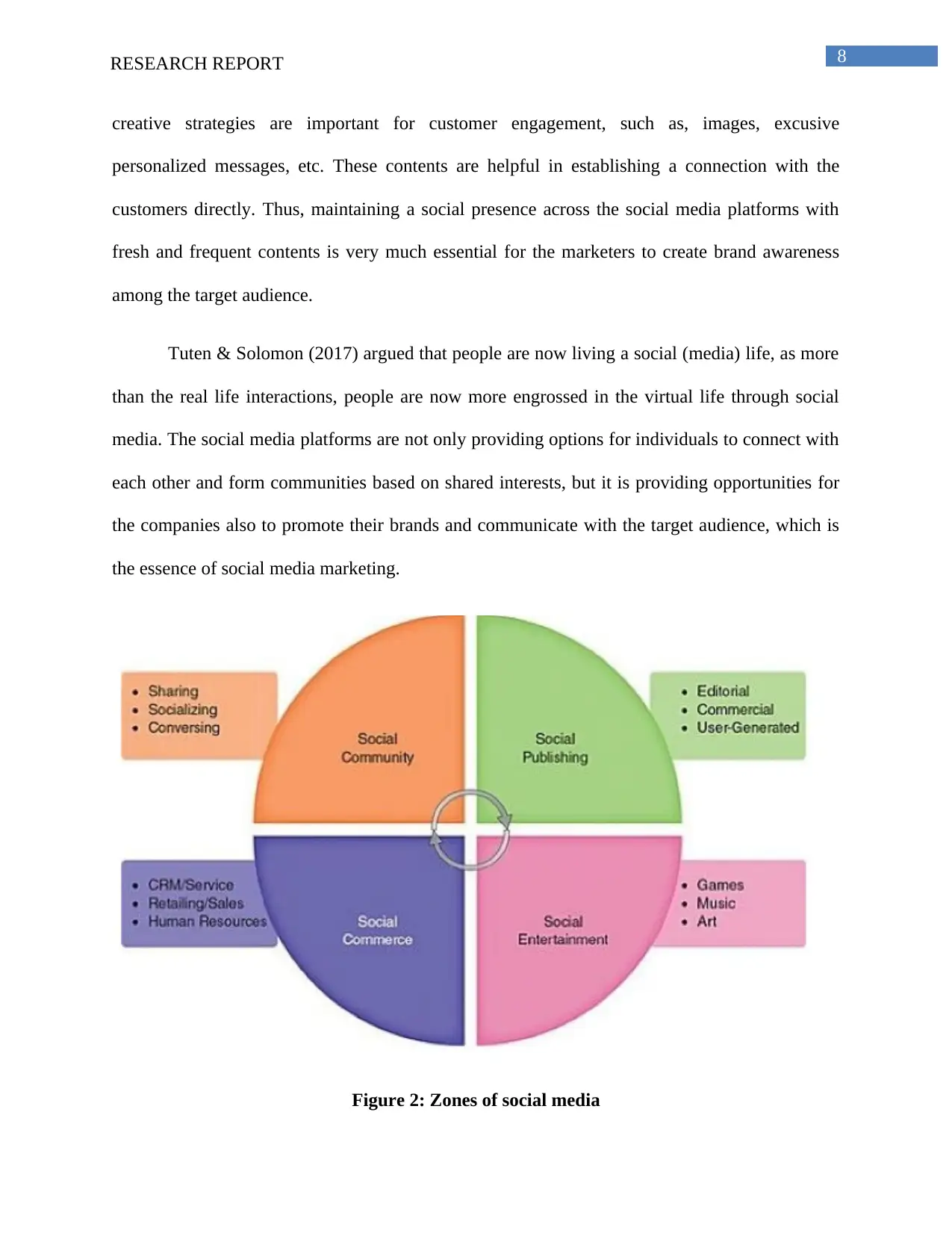
8RESEARCH REPORT
creative strategies are important for customer engagement, such as, images, excusive
personalized messages, etc. These contents are helpful in establishing a connection with the
customers directly. Thus, maintaining a social presence across the social media platforms with
fresh and frequent contents is very much essential for the marketers to create brand awareness
among the target audience.
Tuten & Solomon (2017) argued that people are now living a social (media) life, as more
than the real life interactions, people are now more engrossed in the virtual life through social
media. The social media platforms are not only providing options for individuals to connect with
each other and form communities based on shared interests, but it is providing opportunities for
the companies also to promote their brands and communicate with the target audience, which is
the essence of social media marketing.
Figure 2: Zones of social media
creative strategies are important for customer engagement, such as, images, excusive
personalized messages, etc. These contents are helpful in establishing a connection with the
customers directly. Thus, maintaining a social presence across the social media platforms with
fresh and frequent contents is very much essential for the marketers to create brand awareness
among the target audience.
Tuten & Solomon (2017) argued that people are now living a social (media) life, as more
than the real life interactions, people are now more engrossed in the virtual life through social
media. The social media platforms are not only providing options for individuals to connect with
each other and form communities based on shared interests, but it is providing opportunities for
the companies also to promote their brands and communicate with the target audience, which is
the essence of social media marketing.
Figure 2: Zones of social media
⊘ This is a preview!⊘
Do you want full access?
Subscribe today to unlock all pages.

Trusted by 1+ million students worldwide
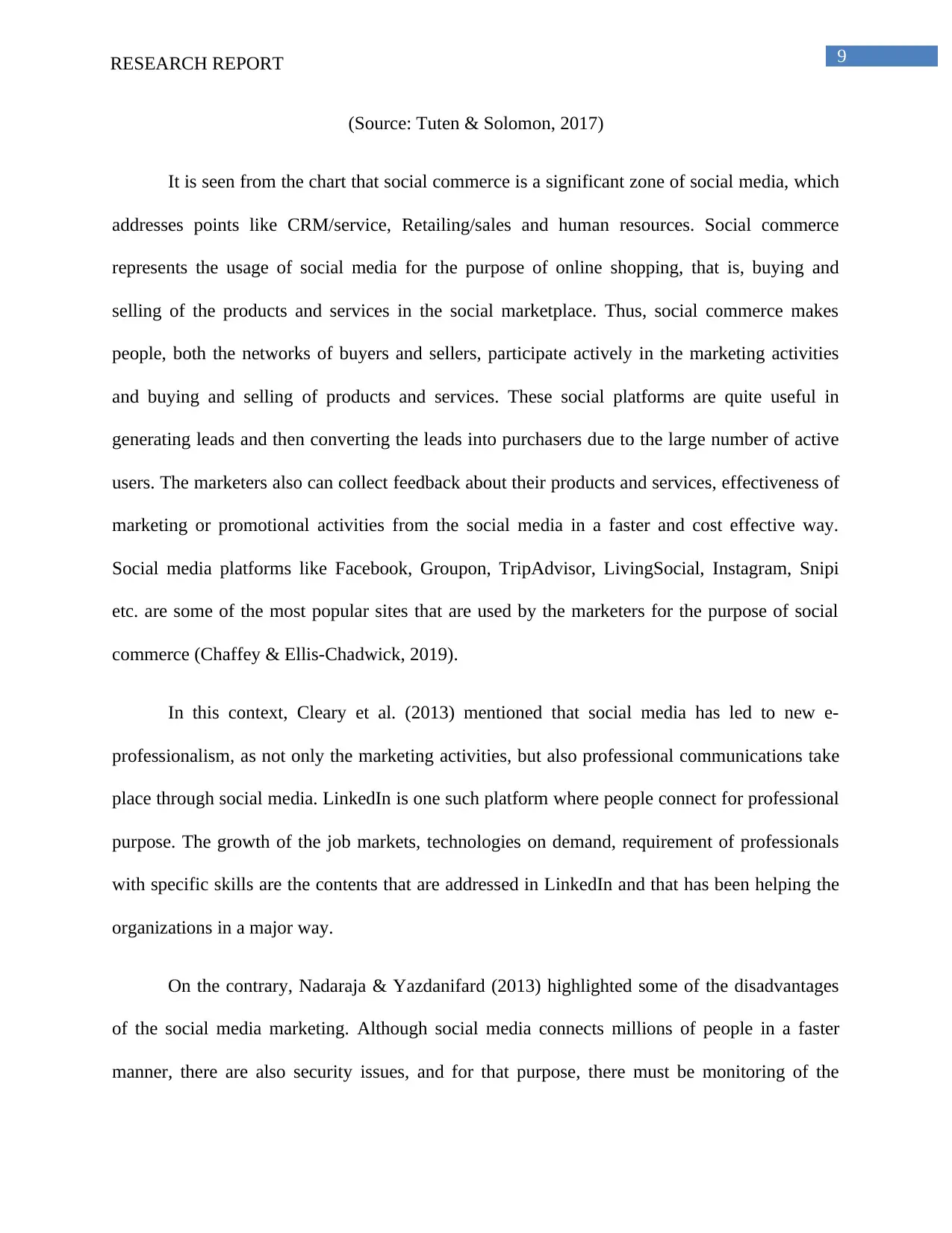
9RESEARCH REPORT
(Source: Tuten & Solomon, 2017)
It is seen from the chart that social commerce is a significant zone of social media, which
addresses points like CRM/service, Retailing/sales and human resources. Social commerce
represents the usage of social media for the purpose of online shopping, that is, buying and
selling of the products and services in the social marketplace. Thus, social commerce makes
people, both the networks of buyers and sellers, participate actively in the marketing activities
and buying and selling of products and services. These social platforms are quite useful in
generating leads and then converting the leads into purchasers due to the large number of active
users. The marketers also can collect feedback about their products and services, effectiveness of
marketing or promotional activities from the social media in a faster and cost effective way.
Social media platforms like Facebook, Groupon, TripAdvisor, LivingSocial, Instagram, Snipi
etc. are some of the most popular sites that are used by the marketers for the purpose of social
commerce (Chaffey & Ellis-Chadwick, 2019).
In this context, Cleary et al. (2013) mentioned that social media has led to new e-
professionalism, as not only the marketing activities, but also professional communications take
place through social media. LinkedIn is one such platform where people connect for professional
purpose. The growth of the job markets, technologies on demand, requirement of professionals
with specific skills are the contents that are addressed in LinkedIn and that has been helping the
organizations in a major way.
On the contrary, Nadaraja & Yazdanifard (2013) highlighted some of the disadvantages
of the social media marketing. Although social media connects millions of people in a faster
manner, there are also security issues, and for that purpose, there must be monitoring of the
(Source: Tuten & Solomon, 2017)
It is seen from the chart that social commerce is a significant zone of social media, which
addresses points like CRM/service, Retailing/sales and human resources. Social commerce
represents the usage of social media for the purpose of online shopping, that is, buying and
selling of the products and services in the social marketplace. Thus, social commerce makes
people, both the networks of buyers and sellers, participate actively in the marketing activities
and buying and selling of products and services. These social platforms are quite useful in
generating leads and then converting the leads into purchasers due to the large number of active
users. The marketers also can collect feedback about their products and services, effectiveness of
marketing or promotional activities from the social media in a faster and cost effective way.
Social media platforms like Facebook, Groupon, TripAdvisor, LivingSocial, Instagram, Snipi
etc. are some of the most popular sites that are used by the marketers for the purpose of social
commerce (Chaffey & Ellis-Chadwick, 2019).
In this context, Cleary et al. (2013) mentioned that social media has led to new e-
professionalism, as not only the marketing activities, but also professional communications take
place through social media. LinkedIn is one such platform where people connect for professional
purpose. The growth of the job markets, technologies on demand, requirement of professionals
with specific skills are the contents that are addressed in LinkedIn and that has been helping the
organizations in a major way.
On the contrary, Nadaraja & Yazdanifard (2013) highlighted some of the disadvantages
of the social media marketing. Although social media connects millions of people in a faster
manner, there are also security issues, and for that purpose, there must be monitoring of the
Paraphrase This Document
Need a fresh take? Get an instant paraphrase of this document with our AI Paraphraser
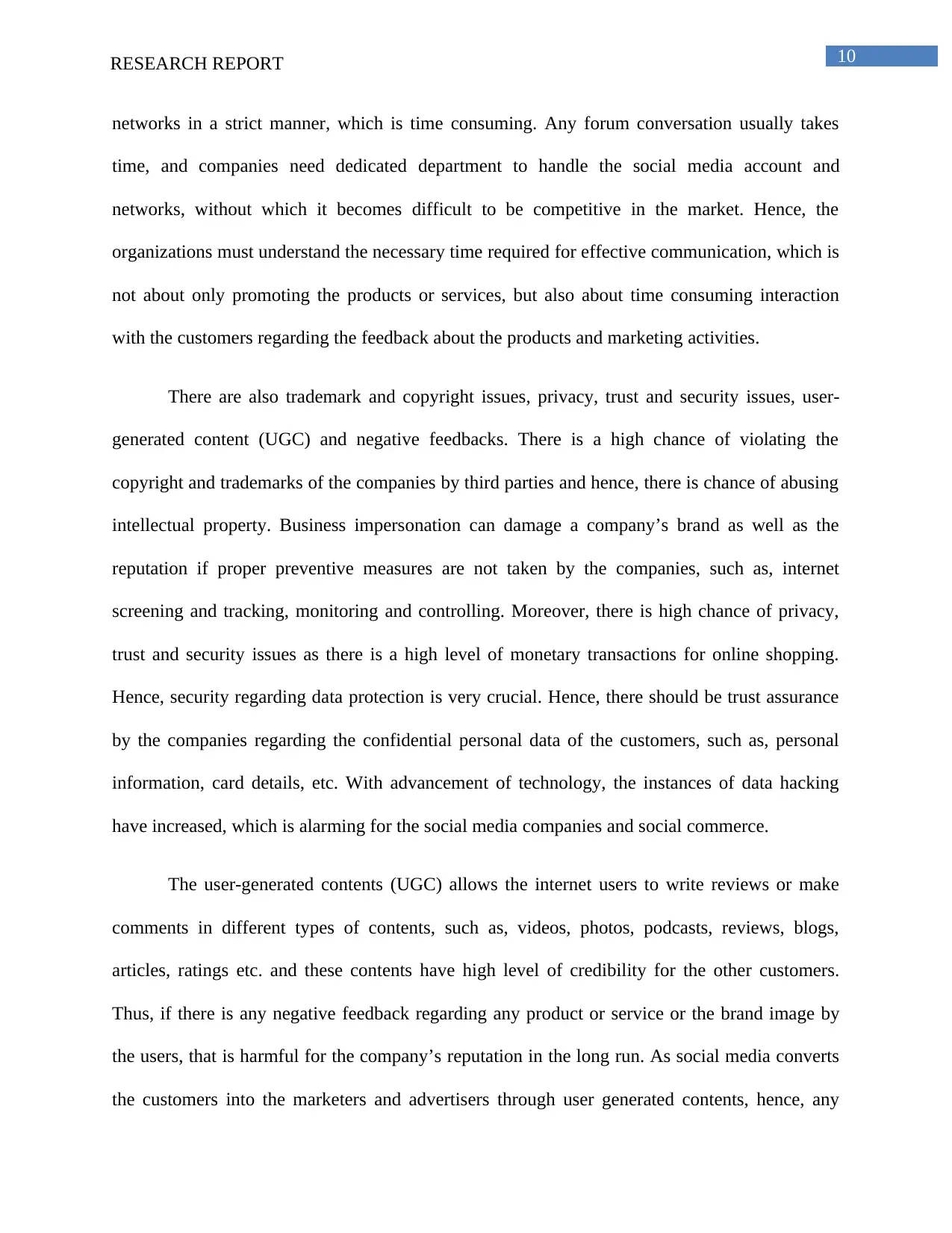
10RESEARCH REPORT
networks in a strict manner, which is time consuming. Any forum conversation usually takes
time, and companies need dedicated department to handle the social media account and
networks, without which it becomes difficult to be competitive in the market. Hence, the
organizations must understand the necessary time required for effective communication, which is
not about only promoting the products or services, but also about time consuming interaction
with the customers regarding the feedback about the products and marketing activities.
There are also trademark and copyright issues, privacy, trust and security issues, user-
generated content (UGC) and negative feedbacks. There is a high chance of violating the
copyright and trademarks of the companies by third parties and hence, there is chance of abusing
intellectual property. Business impersonation can damage a company’s brand as well as the
reputation if proper preventive measures are not taken by the companies, such as, internet
screening and tracking, monitoring and controlling. Moreover, there is high chance of privacy,
trust and security issues as there is a high level of monetary transactions for online shopping.
Hence, security regarding data protection is very crucial. Hence, there should be trust assurance
by the companies regarding the confidential personal data of the customers, such as, personal
information, card details, etc. With advancement of technology, the instances of data hacking
have increased, which is alarming for the social media companies and social commerce.
The user-generated contents (UGC) allows the internet users to write reviews or make
comments in different types of contents, such as, videos, photos, podcasts, reviews, blogs,
articles, ratings etc. and these contents have high level of credibility for the other customers.
Thus, if there is any negative feedback regarding any product or service or the brand image by
the users, that is harmful for the company’s reputation in the long run. As social media converts
the customers into the marketers and advertisers through user generated contents, hence, any
networks in a strict manner, which is time consuming. Any forum conversation usually takes
time, and companies need dedicated department to handle the social media account and
networks, without which it becomes difficult to be competitive in the market. Hence, the
organizations must understand the necessary time required for effective communication, which is
not about only promoting the products or services, but also about time consuming interaction
with the customers regarding the feedback about the products and marketing activities.
There are also trademark and copyright issues, privacy, trust and security issues, user-
generated content (UGC) and negative feedbacks. There is a high chance of violating the
copyright and trademarks of the companies by third parties and hence, there is chance of abusing
intellectual property. Business impersonation can damage a company’s brand as well as the
reputation if proper preventive measures are not taken by the companies, such as, internet
screening and tracking, monitoring and controlling. Moreover, there is high chance of privacy,
trust and security issues as there is a high level of monetary transactions for online shopping.
Hence, security regarding data protection is very crucial. Hence, there should be trust assurance
by the companies regarding the confidential personal data of the customers, such as, personal
information, card details, etc. With advancement of technology, the instances of data hacking
have increased, which is alarming for the social media companies and social commerce.
The user-generated contents (UGC) allows the internet users to write reviews or make
comments in different types of contents, such as, videos, photos, podcasts, reviews, blogs,
articles, ratings etc. and these contents have high level of credibility for the other customers.
Thus, if there is any negative feedback regarding any product or service or the brand image by
the users, that is harmful for the company’s reputation in the long run. As social media converts
the customers into the marketers and advertisers through user generated contents, hence, any
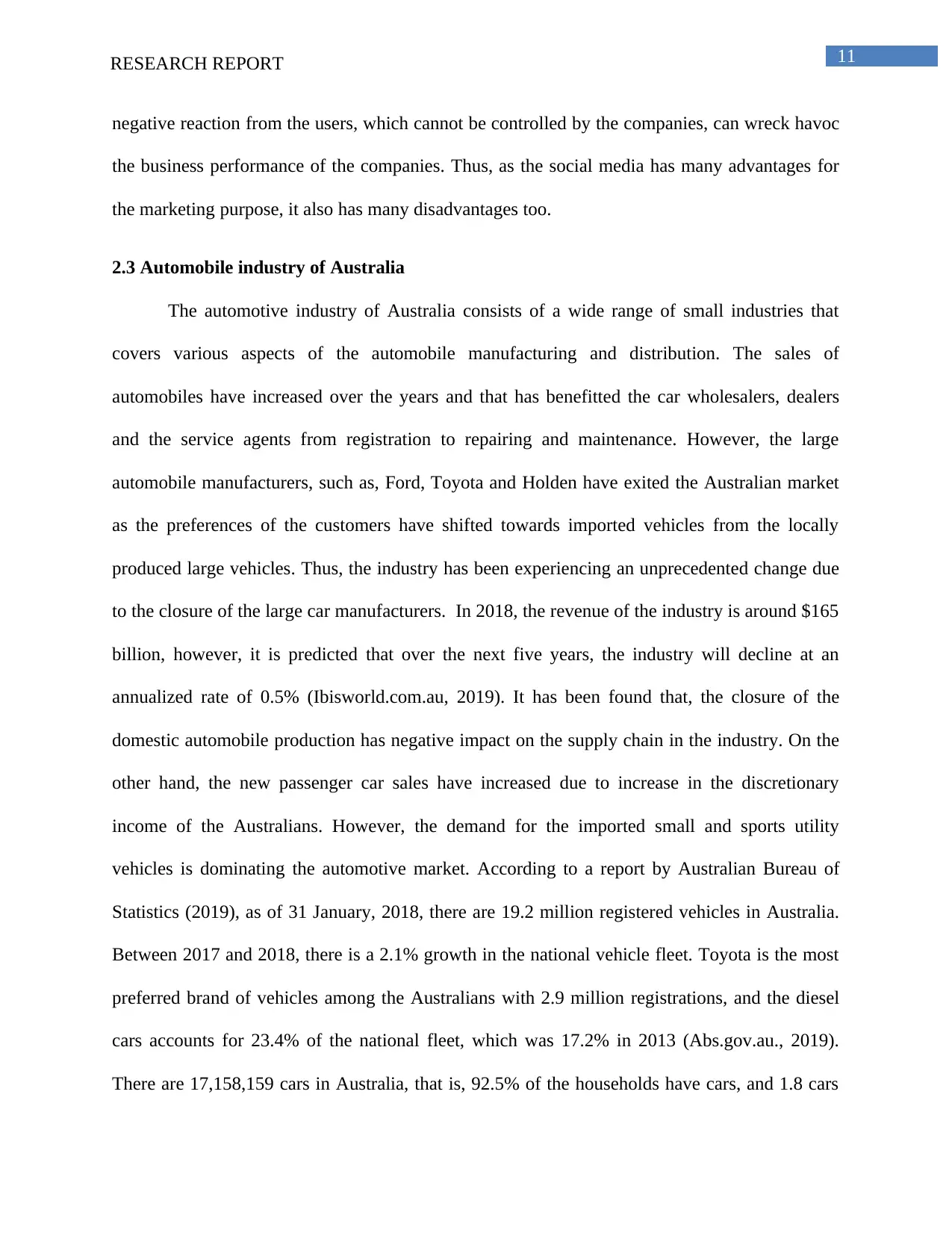
11RESEARCH REPORT
negative reaction from the users, which cannot be controlled by the companies, can wreck havoc
the business performance of the companies. Thus, as the social media has many advantages for
the marketing purpose, it also has many disadvantages too.
2.3 Automobile industry of Australia
The automotive industry of Australia consists of a wide range of small industries that
covers various aspects of the automobile manufacturing and distribution. The sales of
automobiles have increased over the years and that has benefitted the car wholesalers, dealers
and the service agents from registration to repairing and maintenance. However, the large
automobile manufacturers, such as, Ford, Toyota and Holden have exited the Australian market
as the preferences of the customers have shifted towards imported vehicles from the locally
produced large vehicles. Thus, the industry has been experiencing an unprecedented change due
to the closure of the large car manufacturers. In 2018, the revenue of the industry is around $165
billion, however, it is predicted that over the next five years, the industry will decline at an
annualized rate of 0.5% (Ibisworld.com.au, 2019). It has been found that, the closure of the
domestic automobile production has negative impact on the supply chain in the industry. On the
other hand, the new passenger car sales have increased due to increase in the discretionary
income of the Australians. However, the demand for the imported small and sports utility
vehicles is dominating the automotive market. According to a report by Australian Bureau of
Statistics (2019), as of 31 January, 2018, there are 19.2 million registered vehicles in Australia.
Between 2017 and 2018, there is a 2.1% growth in the national vehicle fleet. Toyota is the most
preferred brand of vehicles among the Australians with 2.9 million registrations, and the diesel
cars accounts for 23.4% of the national fleet, which was 17.2% in 2013 (Abs.gov.au., 2019).
There are 17,158,159 cars in Australia, that is, 92.5% of the households have cars, and 1.8 cars
negative reaction from the users, which cannot be controlled by the companies, can wreck havoc
the business performance of the companies. Thus, as the social media has many advantages for
the marketing purpose, it also has many disadvantages too.
2.3 Automobile industry of Australia
The automotive industry of Australia consists of a wide range of small industries that
covers various aspects of the automobile manufacturing and distribution. The sales of
automobiles have increased over the years and that has benefitted the car wholesalers, dealers
and the service agents from registration to repairing and maintenance. However, the large
automobile manufacturers, such as, Ford, Toyota and Holden have exited the Australian market
as the preferences of the customers have shifted towards imported vehicles from the locally
produced large vehicles. Thus, the industry has been experiencing an unprecedented change due
to the closure of the large car manufacturers. In 2018, the revenue of the industry is around $165
billion, however, it is predicted that over the next five years, the industry will decline at an
annualized rate of 0.5% (Ibisworld.com.au, 2019). It has been found that, the closure of the
domestic automobile production has negative impact on the supply chain in the industry. On the
other hand, the new passenger car sales have increased due to increase in the discretionary
income of the Australians. However, the demand for the imported small and sports utility
vehicles is dominating the automotive market. According to a report by Australian Bureau of
Statistics (2019), as of 31 January, 2018, there are 19.2 million registered vehicles in Australia.
Between 2017 and 2018, there is a 2.1% growth in the national vehicle fleet. Toyota is the most
preferred brand of vehicles among the Australians with 2.9 million registrations, and the diesel
cars accounts for 23.4% of the national fleet, which was 17.2% in 2013 (Abs.gov.au., 2019).
There are 17,158,159 cars in Australia, that is, 92.5% of the households have cars, and 1.8 cars
⊘ This is a preview!⊘
Do you want full access?
Subscribe today to unlock all pages.

Trusted by 1+ million students worldwide
1 out of 20
Related Documents
Your All-in-One AI-Powered Toolkit for Academic Success.
+13062052269
info@desklib.com
Available 24*7 on WhatsApp / Email
![[object Object]](/_next/static/media/star-bottom.7253800d.svg)
Unlock your academic potential
Copyright © 2020–2025 A2Z Services. All Rights Reserved. Developed and managed by ZUCOL.





